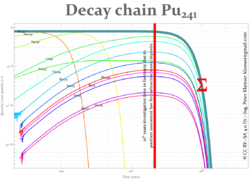Physics:Bateman equation
In nuclear physics, the Bateman equation is a mathematical model describing abundances and activities in a decay chain as a function of time, based on the decay rates and initial abundances. The model was formulated by Ernest Rutherford in 1905[1] and the analytical solution was provided by Harry Bateman in 1910.[2] If, at time t, there are [math]\displaystyle{ N_i(t) }[/math] atoms of isotope [math]\displaystyle{ i }[/math] that decays into isotope [math]\displaystyle{ i+1 }[/math] at the rate [math]\displaystyle{ \lambda_i }[/math], the amounts of isotopes in the k-step decay chain evolves as:
- [math]\displaystyle{ \begin{align} \frac{dN_1(t)}{dt} & =-\lambda_1 N_1(t) \\[3pt] \frac{dN_i(t)}{dt} & =-\lambda_i N_i(t) + \lambda_{i-1}N_{i-1}(t) \\[3pt] \frac{dN_k(t)}{dt} & = \lambda_{k-1}N_{k-1}(t) \end{align} }[/math]
(this can be adapted to handle decay branches). While this can be solved explicitly for i = 2, the formulas quickly become cumbersome for longer chains.[3] The Bateman equation is a classical master equation where the transition rates are only allowed from one species (i) to the next (i+1) but never in the reverse sense (i+1 to i is forbidden).
Bateman found a general explicit formula for the amounts by taking the Laplace transform of the variables.
- [math]\displaystyle{ N_n(t)=N_1(0)\times\left(\prod_{i=1}^{n-1}\lambda_i\right)\times\sum_{i=1}^n\frac{e^{-\lambda_i t}}{\prod\limits_{j=1,j\neq i}^{n}\left(\lambda_j-\lambda_i\right)} }[/math]
(it can also be expanded with source terms, if more atoms of isotope i are provided externally at a constant rate).[4]

While the Bateman formula can be implemented in a computer code, if [math]\displaystyle{ \lambda_j \approx \lambda_i }[/math] for some isotope pair, catastrophic cancellation can lead to computational errors. Therefore, other methods such as numerical integration or the matrix exponential method are also in use.[5]
For example, for the simple case of a chain of three isotopes the corresponding Bateman equation reduces to
- [math]\displaystyle{ \begin{align} & A \,\xrightarrow{\lambda_A}\, B \,\xrightarrow{\lambda_B}\, C \\[4pt] & N_B= \frac{\lambda_A}{\lambda_B-\lambda_A}N_{A_0} \left( e^{-\lambda_A t} - e^{-\lambda_B t} \right) \end{align} }[/math]
Which gives the following formula for activity of isotope [math]\displaystyle{ B }[/math] (by substituting [math]\displaystyle{ A=\lambda N }[/math])
- [math]\displaystyle{ \begin{align} A_B= \frac{\lambda_B}{\lambda_B-\lambda_A}A_{A_0} \left( e^{-\lambda_A t} - e^{-\lambda_B t} \right) \end{align} }[/math]
See also
- Harry Bateman
- List of equations in nuclear and particle physics
- Transient equilibrium
- Secular equilibrium
- Pharmacokinetics, loose applicability
References
- ↑ Rutherford, E. (1905). Radio-activity. University Press. p. 331
- ↑ Bateman, H. (1910, June). The solution of a system of differential equations occurring in the theory of radioactive transformations. In Proc. Cambridge Philos. Soc (Vol. 15, No. pt V, pp. 423–427) https://archive.org/details/cbarchive_122715_solutionofasystemofdifferentia1843
- ↑ "Archived copy". Archived from the original on 2013-09-27. https://web.archive.org/web/20130927064244/http://chemistry.sfu.ca/assets/uploads/file/Course%20Materials%2012-1/NUSC%20342/L9.pdf. Retrieved 2013-09-22.
- ↑ "Nucleonica". http://www.nucleonica.com/wiki/index.php?title=Help%3ADecay_Engine%2B%2B.
- ↑ Harr, Logan (2007-03-15). "Precise Calculation of Complex Radioactive Decay Chains" (PDF). Theses and Dissertations. 2007. https://scholar.afit.edu/etd/2924.
 |

